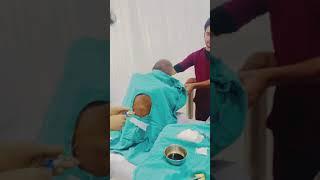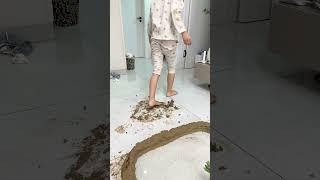
Pleural Tapping Procedure | Pleural Aspiration | Thoracentesis | Pleural Tap | By DR RAJ MISHRA #dr
Indications for Thoracentesis
Diagnostic thoracentesis
Indicated for almost all patients who have pleural fluid that is new or of uncertain etiology and is ≥ 10 mm in thickness on computed tomography (CT) scan, ultrasonography, or lateral decubitus x-ray (see figure Diagnosis of Pleural Effusion)
Diagnostic thoracentesis is usually not needed when the etiology of the pleural fluid is apparent (eg, viral pleuritis, typical heart failure).
Selection of laboratory tests typically done on pleural fluid is discussed in pleural effusion.
Therapeutic thoracentesis
To relieve symptoms in patients with dyspnea caused by a large pleural effusion
If pleural fluid continues to reaccumulate after several therapeutic thoracenteses, pleurodesis (injection of an irritating substance into the pleural space, which causes obliteration of the space) may help prevent recurrence. Alternatively, placement of an indwelling pleural catheter can allow drainage of pleural fluid by patients at home. Pleurodesis and placement of an indwelling pleural catheter are most commonly done to manage malignant effusions.
Contraindications to Thoracentesis
Absolute contraindications
None
Relative contraindications
Bleeding disorder or anticoagulation
Altered chest wall anatomy
Cellulitis or herpes zoster at the site of thoracentesis puncture
Pulmonary disease severe enough to make complications life threatening
Uncontrolled coughing or an uncooperative patient
Complications of Thoracentesis
Major complications include
Pneumothorax
Bleeding (hemoptysis due to lung puncture)
Re-expansion pulmonary edema and/or hypotension (1)
Equipment for Thoracentesis
Local anesthetic (eg, 10 mL of 1% lidocaine), 25-gauge and 20- to 22-gauge needles, and 10-mL syringe
Antiseptic solution with applicators, drapes, and gloves
Thoracentesis needle and plastic catheter
3-way stopcock
30- to 50-mL syringe
Wound dressing materials
Bedside table for patient to lean on
Appropriate containers for collection of fluid for laboratory tests
Collection bags for removal of larger volumes during therapeutic thoracentesis
Ultrasound machine
Additional Considerations for Thoracentesis
Thoracentesis can be safely done at the patient’s bedside or in an outpatient setting.
Ample local anesthetic is necessary, but procedural sedation is not required in cooperative patients.
Thoracentesis needle should not be inserted through infected skin (eg, cellulitis or herpes zoster).
Positive pressure ventilation can increase the risk of complications.
If the patient is receiving anticoagulant drugs (eg, warfarin), consider giving fresh frozen plasma or another reversal agent prior to the procedure.
Bloody fluid that does not clot in a collecting tube indicates that blood in the pleural space was not iatrogenic, because free blood in the pleural space rapidly defibrinates.
Only unstable patients and patients at high risk of decompensation due to complications require monitoring (eg, pulse oximetry, electrocardiography [ECG]).
Relevant Anatomy for Thoracentesis
Confirm the extent of the pleural effusion by chest percussion and consider an imaging study; bedside ultrasonography is recommended both to reduce the risk of pneumothorax and to increase the success of the procedure (3).
Select a needle insertion point in the mid-scapular line at the upper border of the rib one intercostal space below the top of the effusion.
Mark the insertion point and prepare the area with a skin cleansing agent such as chlorhexidine and apply a sterile drape while wearing sterile gloves.
Using a 25-gauge needle, place a wheal of local anesthetic over the insertion point. Switch to a larger (20- or 22-gauge) needle and inject anesthetic progressively deeper until reaching the parietal pleura, which should be infiltrated the most because it is very sensitive. Continue advancing the needle until pleural fluid is aspirated and note the depth of the needle at which this occurs.
Attach a large-bore (16- to 19-gauge) thoracentesis needle-catheter device to a 3-way stopcock, place a 30- to 50-mL syringe on one port of the stopcock and attach drainage tubing to the other port.
Insert the needle along the upper border of the rib while aspirating and advance it into the effusion.
When fluid or blood is aspirated, insert the catheter over the needle into the pleural space and withdraw the needle, leaving the catheter in the pleural space. While preparing to insert the catheter, cover the needle opening during inspiration to prevent entry of air into the pleural space.
Withdraw 30 mL of fluid into the syringe and place the fluid in appropriate tubes and bottles for testing.
If a larger amount of fluid is to be drained, turn the stopcock and allow fluid to drain into a collection bag or bottle. Alternatively, aspirate fluid using the syringe, taking care to periodically release pressure on the plunger.
Diagnostic thoracentesis
Indicated for almost all patients who have pleural fluid that is new or of uncertain etiology and is ≥ 10 mm in thickness on computed tomography (CT) scan, ultrasonography, or lateral decubitus x-ray (see figure Diagnosis of Pleural Effusion)
Diagnostic thoracentesis is usually not needed when the etiology of the pleural fluid is apparent (eg, viral pleuritis, typical heart failure).
Selection of laboratory tests typically done on pleural fluid is discussed in pleural effusion.
Therapeutic thoracentesis
To relieve symptoms in patients with dyspnea caused by a large pleural effusion
If pleural fluid continues to reaccumulate after several therapeutic thoracenteses, pleurodesis (injection of an irritating substance into the pleural space, which causes obliteration of the space) may help prevent recurrence. Alternatively, placement of an indwelling pleural catheter can allow drainage of pleural fluid by patients at home. Pleurodesis and placement of an indwelling pleural catheter are most commonly done to manage malignant effusions.
Contraindications to Thoracentesis
Absolute contraindications
None
Relative contraindications
Bleeding disorder or anticoagulation
Altered chest wall anatomy
Cellulitis or herpes zoster at the site of thoracentesis puncture
Pulmonary disease severe enough to make complications life threatening
Uncontrolled coughing or an uncooperative patient
Complications of Thoracentesis
Major complications include
Pneumothorax
Bleeding (hemoptysis due to lung puncture)
Re-expansion pulmonary edema and/or hypotension (1)
Equipment for Thoracentesis
Local anesthetic (eg, 10 mL of 1% lidocaine), 25-gauge and 20- to 22-gauge needles, and 10-mL syringe
Antiseptic solution with applicators, drapes, and gloves
Thoracentesis needle and plastic catheter
3-way stopcock
30- to 50-mL syringe
Wound dressing materials
Bedside table for patient to lean on
Appropriate containers for collection of fluid for laboratory tests
Collection bags for removal of larger volumes during therapeutic thoracentesis
Ultrasound machine
Additional Considerations for Thoracentesis
Thoracentesis can be safely done at the patient’s bedside or in an outpatient setting.
Ample local anesthetic is necessary, but procedural sedation is not required in cooperative patients.
Thoracentesis needle should not be inserted through infected skin (eg, cellulitis or herpes zoster).
Positive pressure ventilation can increase the risk of complications.
If the patient is receiving anticoagulant drugs (eg, warfarin), consider giving fresh frozen plasma or another reversal agent prior to the procedure.
Bloody fluid that does not clot in a collecting tube indicates that blood in the pleural space was not iatrogenic, because free blood in the pleural space rapidly defibrinates.
Only unstable patients and patients at high risk of decompensation due to complications require monitoring (eg, pulse oximetry, electrocardiography [ECG]).
Relevant Anatomy for Thoracentesis
Confirm the extent of the pleural effusion by chest percussion and consider an imaging study; bedside ultrasonography is recommended both to reduce the risk of pneumothorax and to increase the success of the procedure (3).
Select a needle insertion point in the mid-scapular line at the upper border of the rib one intercostal space below the top of the effusion.
Mark the insertion point and prepare the area with a skin cleansing agent such as chlorhexidine and apply a sterile drape while wearing sterile gloves.
Using a 25-gauge needle, place a wheal of local anesthetic over the insertion point. Switch to a larger (20- or 22-gauge) needle and inject anesthetic progressively deeper until reaching the parietal pleura, which should be infiltrated the most because it is very sensitive. Continue advancing the needle until pleural fluid is aspirated and note the depth of the needle at which this occurs.
Attach a large-bore (16- to 19-gauge) thoracentesis needle-catheter device to a 3-way stopcock, place a 30- to 50-mL syringe on one port of the stopcock and attach drainage tubing to the other port.
Insert the needle along the upper border of the rib while aspirating and advance it into the effusion.
When fluid or blood is aspirated, insert the catheter over the needle into the pleural space and withdraw the needle, leaving the catheter in the pleural space. While preparing to insert the catheter, cover the needle opening during inspiration to prevent entry of air into the pleural space.
Withdraw 30 mL of fluid into the syringe and place the fluid in appropriate tubes and bottles for testing.
If a larger amount of fluid is to be drained, turn the stopcock and allow fluid to drain into a collection bag or bottle. Alternatively, aspirate fluid using the syringe, taking care to periodically release pressure on the plunger.
Комментарии:
Pleural Tapping Procedure | Pleural Aspiration | Thoracentesis | Pleural Tap | By DR RAJ MISHRA #dr
Medical knowledge with DR RAJ MISHRA
HEAT STROKE management & treatment #heat #stroke #medical #shorts #reels Dr Raj Mishra #doctor
Medical knowledge with DR RAJ MISHRA
5 Used Cars You Should Never Buy
Scotty Kilmer










![[KPOP IN PUBLIC - NOBODY CREW] [#퀸덤퍼즐] ATHENA (아테나) - Snap | [ITALY] [KPOP IN PUBLIC - NOBODY CREW] [#퀸덤퍼즐] ATHENA (아테나) - Snap | [ITALY]](https://ruvideo.cc/img/upload/a0FIR0dSNEg2V1Q.jpg)















